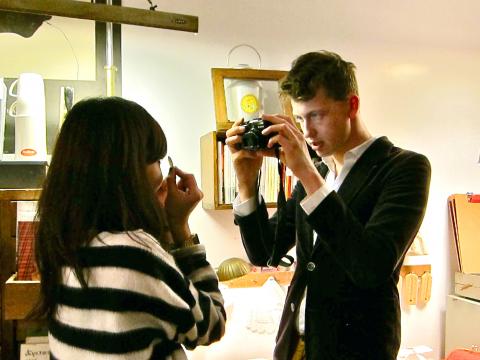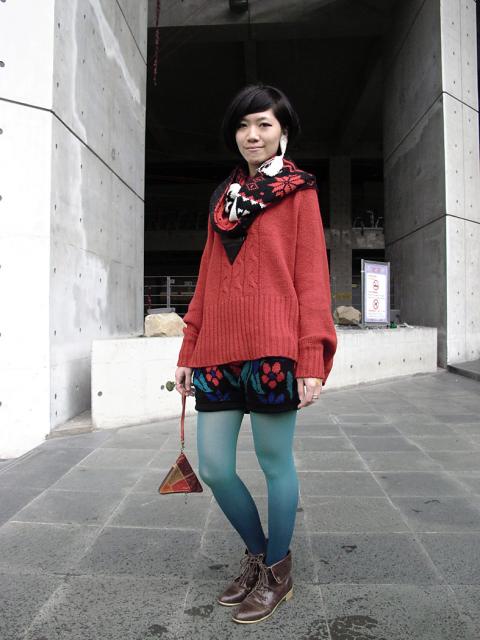Yvan Rodic is a hunter: his weapon, a Canon G12, and his prey, the stylishly eccentric (or eccentrically stylish).
Five years ago, Rodic started his blog Facehunter (facehunter.blogspot.com) to post party photos he took in Paris, where he then lived, online. Now it is one of the best-known street style blogs. Rodic’s recently published book, also called Facehunter, includes 326 images culled from his site.
The 33-year-old landed in Taipei last week as part of a seven-country book tour of Asia. During a signing at VVG Something (好樣本事) in Taipei on Friday evening, Rodic took outfit shots of two women: one sporting a platinum blonde bob, the other wearing a graphic print black-and-white minidress. The lanky Rodic hunched over to get on eye level with his subjects and gently cajoled them to pose naturally. Contrary to his blog’s name, he is charming and affable.

Photo: Catherine Shu, Taipei Times and courtesy of Yvan Rodic
Rodic had no background in fashion or photography when he launched Facehunter in January 2006 after receiving a compact camera as a gift.
“I grew up in Switzerland and in Switzerland you don’t really have any concept of fashion. It’s all really functional and the only thing people wore were snowboarding clothes,” he says.
Then working as a copywriter, Rodic took portrait shots of guests at parties and gallery openings, handing out name cards with his blog’s Web address.

Photo: Catherine Shu, Taipei Times and courtesy of Yvan Rodic
Within six months, men.style.com (now GQ.com) asked him to cover New York Fashion Week. Since then, Rodic has contributed to publications including The Observer, French GQ and Tokion Magazine. His book was published this January and Rodic is now pitching his Web television series, The Facehunter Show, to networks in the US. Rodic says that his blog gets 30,000 visitors a day.
Street style blogs similar to Facehunter and The Sartorialist (thesartorialist.blogspot.com) have proliferated — Jak & Jil, Altamira, Hanneli, Hel Looks and Garance Dore are among the best known. Rodic says major fashion weeks are now rife with bloggers and photographers more intent on snapping off-duty models and audience members than the runway shows.
“[At] the first fashion week I did four years ago, there was actually only Scott Schuman [of The Sartorialist] and me,” he says. “Now you can literally be with 50 other photographers taking the same photo.”
Blogs like his have minimized “the monopoly on inspiration of the magazines,” Rodic says. “I think blogs bring the idea that fashion is more participative. It shows that instead of having a few trends that are printed by the top publications, there are an infinite quantity of options and that there is no ‘in’ or ‘out.’”
On one page of Rodic’s book, a bearded man flaunts a colorful scarf hand-knit by his grandmother and a porkpie hat during Paris Fashion Week; opposite his photograph is one of a young woman in London wearing an oversized Fair Isle sweater with twee ducks and little red hearts. On the next page, Ioanna Gika, lead singer of Io Echo, poses in Los Angeles’ Branson Canyon sporting a dramatic color-blocked shift.
Instead of tracking trends — a word he dislikes — Rodic says he simply photographs people who catch his eye. “My work is based on my personal taste and intuition that the people I see have their own thing and are true to their personality.”
Rodic counts Hipster Runoff (www.hipsterrunoff.com) as one of his favorite blogs, though his photographs are frequent targets of the satirical site.
“I can understand. I mean, it’s not so far from reality,” Rodic says. “But most of the people on [Facehunter] are not hipsters. They are just young and creative, so I think that’s the shortest way to sum them up.”
Though they purport to present a more populist view of fashion, street style blogs have been accused of showing the same kind of people that fashion magazines do: attractive, slender and youthful.
“In the end I shoot who I like, but I guess my standards of beauty are probably influenced by the world I grew up in,” he says. “I think it’d be very politically correct in a horrible way to say, ‘Oh, I’m going to be shooting quotas of types of people.’”
Rodic differentiates the Facehunter brand from other street style blogs by covering attendees at less well-known fashion weeks in locations including Istanbul, Copenhagen and Sao Paulo and events like Coachella Music and Arts Festival and the Sundance Film Festival. This year Rodic took 104 airplane flights to 35 countries. (When he isn’t traveling, he lives in London.)
Most people are curious and flattered when he approaches them, says Rodic, but his work occasionally conflicts with local cultural mores. The most difficult places he’s shot in are Colombia and Israel. In Colombia, “it’s like women are owned by men, basically. It’s horrible to say, but women would tell me that ‘I have to ask my husband if you can photograph me,’ and the husband would say, ‘No, she’s my wife.’”
In Tel Aviv, people were “really, really afraid” when Rodic approached them for a photo. “Someone told me that in Israel, for some people, a camera is like a gun. It has a form of violence in it.”
Rodic says that he’s heard designers at Dior and major retailers like Topshop and H&M follow Facehunter. But he adds that it is naive to assume that “designers [once] inspired the street, and now the street inspires designers.”
“It’s just a situation where we are all more creative than ever,” Rodic says. “I think the main thing is more about the approach of the people to get inspired and to do their own thing.”

The canonical shot of an East Asian city is a night skyline studded with towering apartment and office buildings, bright with neon and plastic signage, a landscape of energy and modernity. Another classic image is the same city seen from above, in which identical apartment towers march across the city, spilling out over nearby geography, like stylized soldiers colonizing new territory in a board game. Densely populated dynamic conurbations of money, technological innovation and convenience, it is hard to see the cities of East Asia as what they truly are: necropolises. Why is this? The East Asian development model, with

Desperate dads meet in car parks to exchange packets; exhausted parents slip it into their kids’ drinks; families wait months for prescriptions buy it “off label.” But is it worth the risk? “The first time I gave him a gummy, I thought, ‘Oh my God, have I killed him?’ He just passed out in front of the TV. That never happens.” Jen remembers giving her son, David, six, melatonin to help him sleep. She got them from a friend, a pediatrician who gave them to her own child. “It was sort of hilarious. She had half a tub of gummies,

The wide-screen spectacle of Formula One gets a gleaming, rip-roaring workout in Joseph Kosinski’s F1, a fine-tuned machine of a movie that, in its most riveting racing scenes, approaches a kind of high-speed splendor. Kosinski, who last endeavored to put moviegoers in the seat of a fighter jet in Top Gun: Maverick, has moved to the open cockpits of Formula One with much the same affection, if not outright need, for speed. A lot of the same team is back. Jerry Bruckheimer produces. Ehren Kruger, a co-writer on Maverick, takes sole credit here. Hans Zimmer, a co-composer previously, supplies the thumping

There is an old British curse, “may you live in interesting times,” passed off as ancient Chinese wisdom to make it sound more exotic and profound. We are living in interesting times. From US President Donald Trump’s decision on American tariffs, to how the recalls will play out, to uncertainty about how events are evolving in China, we can do nothing more than wait with bated breath. At the cusp of potentially momentous change, it is a good time to take stock of the current state of Taiwan’s political parties. As things stand, all three major parties are struggling. For our examination of the